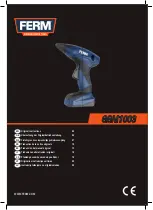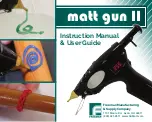
9
– when changing one driving location to another
involves the use of scaffoldings, stairs, ladders, or
ladder alike constructions, e.g. roof laths;
– closing boxes or crates;
– fitting transportation safety systems e.g. on vehicles
and wagons.
• Check walls, ceilings, floors, roofing and the like
carefully to avoid possible electrical shock, gas
leakage, explosions, etc. caused by striking live wires,
conduits or gas pipes.
• Do not use the tool for fastening electrical cables. It is
not designed for electric cable installation and may
damage the insulation of electric cables thereby
causing electric shock or fire hazards.
• Watch your footing and maintain your balance with the
tool. Make sure there is no one below when working in
high locations to prevent danger if there is sudden
jerking or catching.
• On rooftops and other high locations, drive fasteners
as you move forward. It is easy to lose your footing if
you drive fasteners while inching backward. When
driving fasteners against perpendicular surface, work
from the top to the bottom. You can perform driving
operations with less fatigue by doing so.
• A fastener will be bent or the tool can become jammed
if you mistakenly drive fastener on top of another
fastener or strike a knot in the wood. The fastener may
be thrown and hit someone, or the tool itself can react
dangerously. Place the fasteners with care.
• Never attempt to drive fasteners from both the inside
and outside at the same time. Fasteners may rip
through and/or fly off, presenting a grave danger.
Service
• Perform cleaning and maintenance right after finishing
the job. Keep the tool in tip-top condition. Lubricate
moving parts to prevent rusting and minimize friction-
related wear. Wipe off all dust from the parts.
• Ask Makita authorized service center for periodical
inspection of the tool.
• To maintain product SAFETY and RELIABILITY,
maintenance and repairs should be performed by
Makita Authorized Service Centers, always using
Makita replacement parts.
SAVE THESE INSTRUCTIONS.
WARNING:
DO NOT let comfort or familiarity with product (gained
from repeated use) replace strict adherence to safety
rules for the subject product. MISUSE or failure to
follow the safety rules stated in this instruction
manual may cause serious personal injury.
IMPORTANT SAFETY
INSTRUCTIONS
ENC009-1
FOR BATTERY CARTRIDGE
1.
Before using battery cartridge, read all
instructions and cautionary markings on (1)
battery charger, (2) battery, and (3) product using
battery.
2.
Do not disassemble battery cartridge.
3.
If operating time has become excessively shorter,
stop operating immediately. It may result in a risk
of overheating, possible burns and even an
explosion.
4.
If electrolyte gets into your eyes, rinse them out
with clear water and seek medical attention right
away. It may result in loss of your eyesight.
5.
Do not short the battery cartridge:
(1)
Do not touch the terminals with any
conductive material.
(2)
Avoid storing battery cartridge in a container
with other metal objects such as nails, coins,
etc.
(3)
Do not expose battery cartridge to water or
rain.
A battery short can cause a large current flow,
overheating, possible burns and even a
breakdown.
6.
Do not store the tool and battery cartridge in
locations where the temperature may reach or
exceed 50°C (122°F).
7.
Do not incinerate the battery cartridge even if it is
severely damaged or is completely worn out. The
battery cartridge can explode in a fire.
8.
Be careful not to drop or strike battery.
9.
Do not use a damaged battery.
SAVE THESE INSTRUCTIONS.
Tips for maintaining maximum battery life
1.
Charge the battery cartridge before completely
discharged.
Always stop tool operation and charge the battery
cartridge when you notice less tool power.
2.
Never recharge a fully charged battery cartridge.
Overcharging shortens the battery service life.
3.
Charge the battery cartridge with room
temperature at 10°C - 40°C (50°F - 104°F). Let a hot
battery cartridge cool down before charging it.
Overview of the nailer (Fig. 2)
FUNCTIONAL DESCRIPTION
CAUTION:
• Always be sure to remove the fuel cell, the battery
cartridge and nails before adjusting or checking
function on the tool.
Installing or removing battery cartridge
CAUTION:
• Always switch off the tool before installing or removing
of the battery cartridge.
•
Hold the tool and the battery cartridge firmly when
installing or removing battery cartridge.
Failure to
hold the tool and the battery cartridge firmly may cause
them to slip off your hands and result in damage to the
tool and battery cartridge and a personal injury.
(Fig. 3)
To install the battery cartridge, hold it so that the battery
cartridge front shape fits to that of the battery installment
opening and slip it into place. Insert it all the way until it
locks in place with a little click.
(Fig. 4)
Summary of Contents for GN420C
Page 2: ...2 1 000114 2 013150 3 013181 4 013151 1 2 3 4 5 6 7 8 9 10 11 12 12 12 13 ...
Page 3: ...3 5 013167 6 009445 7 009446 8 009447 9 013152 10 013153 11 013154 12 013155 14 15 16 17 ...
Page 4: ...4 13 013168 14 013156 15 013157 16 013158 17 013159 18 013165 18 19 13 6 6 20 21 ...
Page 5: ...5 19 013160 20 013161 21 010319 22 013166 23 013163 24 013227 4 22 23 5 24 21 ...
Page 6: ...6 25 013164 26 013226 27 013162 25 26 ...
Page 74: ...74 ...
Page 75: ...75 ...
Page 76: ...ALA Makita Corporation Anjo Aichi Japan 885157 993 www makita com ...










































